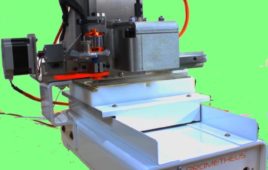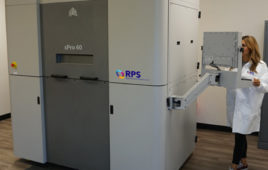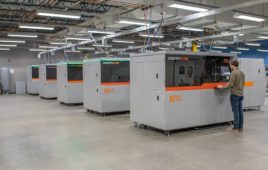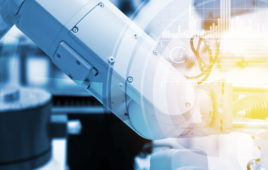For production operations, quality assurance over the process chain is indispensible: it is the only way to detect problems at an early stage and lower additional costs. Fraunhofer researchers developed an efficient type of quality control: With a pointing gesture, employees can input any detected defects to car body parts into the inspection system, and document them there.
With utter meticulousness, the quality control inspector examines a car bumper for defects in the paint work – ultimately, only impeccable body parts get sent to final assembly. If he finds a defect in the paint, just a point of the finger is all it takes to send the defect to the QS inspection system, store it and document it. The employee obtains visual feedback through a monitor that displays a 3D reconstruction of the bumper. At first glance, it might seem completely futuristic, though soon enough, it could become an everyday part of quality assurance: Researchers at the Fraunhofer Institute for Optronics, System Technologies and Image Exploitation IOSB in Karlsruhe engineered the intelligent gesture control system on behalf of the BMW Group. In the future, it should supersede today’s time-consuming test procedures. “Previously, the inspector had to note all defects that were detected, leave his workstation, go to the PC terminal, operate multiple input screens and then label the position of the defect and the defect type. That approach is laborious, time-intensive and prone to error,” asserts Alexander Schick, scientist at IOSB. The gesture control system, by contrast, improves the inspec-
tor’s working conditions considerably, and triggering substantial time savings – the employee can remain at his workstation and interact directly with the test object. “If the bumper is fine, then he swipes over it from left to right. In the event of damage, he points to the location of the defect,” says Schick.
3D tracking records people and objects in real time
This non-contact gesture-detection system is based on 3D data. Hence, the entire workstation must first be reconstructed in 3D. That includes the individual as well as the object with which he is working. “What does the inspector look like? Where is he situated? How does he move? What is he doing? Where is the object? – all of these data are required so that the pointing gesture can properly link to the bumper,” ex-
plains the researcher. In order to enable gesture control, the experts apply 3D-body tracking, which records the individual’s posture in real time. Even the car body parts are “tracked.” When it comes to this, the hardware requirements are minimal: A standard PC and two Microsoft Kinect systems – consisting of camera and 3D sensors – suffice in order to realize the reconstruction. Schick and his team developed the corresponding algorithms, which fuse multiple 2D and 3D images together, specifically for this kind of application, and adapted them to the standards of the BMW Group.
“The breeding ground for this technology is our Smart Control Room, where people can interact with the room quite naturally. They can use pointing gestures to operate remote displays – without any additional equipment. The room recognizes what actions are taking place at that moment, and offers the appropriate information and tools. Since gesture detection does not depend on display screens, this means we can im-
plement applications that use no monitors, like the gesture interaction here with real objects,” explains Schick. “It makes no difference what kind of object we are dealing with. Instead of a bumper, we could also track a different part.”
The technology can be subsequently integrated into existing production systems at little expense. Scientists could incorporate their effective process into the BMW Group’s system through a specialized interface module. The gesture detection system will be presented at the 2013 Hannover Messe, from 8 to 12 April, at the Fraunhofer joint exhibition booth in Hall 2, Booth D18.
Plans call for the installation of a prototype model at the BMW plant in Landshut in January 2013. Working in cooperation with quality control inspectors, the system will be fine-tuned onsite before it gets deployed to production in the future.
For more information visit www.fraunhofer.de.
Filed Under: Rapid prototyping




